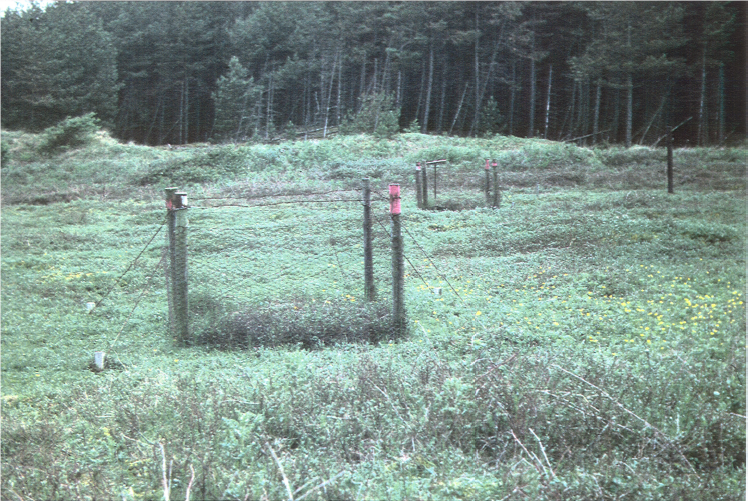natural england’s information board at the entrance to the nnr
natural england’s visitor map of animal grazing areas
site 2 dune slack with exclosures
GREATER BIRD’S FOOT TREFOIL - LOTUS PEDUNCULATUS - IS A COMMON SPECIES IN GRAZED PLOTS
CREEPING WILLOW - SALIX REPENS - IS CHARACTERISTIC OF DUNE SLACK PLANT COMMUNITIES
Background
The Sally Edmondson plots at Ainsdale on the West Lancashire coast were established in 1974 and constitute the longest-running dune slack wetland grazing experiment in the UK. The experiment consists of sheep and rabbit exclosures within sand dune slacks. The experiment is located within Ainsdale Sand Dunes National Nature Reserve, Merseyside, which is owned and managed by Natural England. The reserve in turn is part of Sefton Coast (including Sefton Coast SSSI and Sefton Coast SAC).
Sand dune slacks are low-lying, seasonally-flooded areas within the dune system. They are of high conservation importance, for example being listed in Annex 1 of the EC Habitats and Species Directive (Council Directive 92/43/EEC). They can be particularly rich in plant species, and host rare and local species. Grazing is important in these habitats for maintaining this conservation value, because grazing prevents succession towards scrub. Management often involves the addition of domesticated grazers such as sheep or cattle, but rabbit grazing has been very important historically. Understanding the impact of this grazing is essential for directing conservation management activities. Sand dune systems are also classic models for short-term primary succession on land. The role of grazing in this process is not well understood, so exclosure experiments can provide insight into top-down impacts on such dynamic systems.
Aims
The experiment was established in 1974 by Sally Edmondson with the initial aim of determining the impact of the primary mammalian herbivores at the site—rabbits—on plant community dynamics. In 1991, sheep grazing was introduced onto the reserve. At this time, sheep exclosures were erected around all the rabbit grazing exclosures in two of the dune slacks. The aim now, therefore, is to understand the impact of grazing management and ‘natural’ rabbit grazing on dune slack ecosystem processes.
rabbit grazing exclosure in 1984
…….and here again in 2009
Design
The experiment consists of three 1.5m x 1.5m rabbit exclosures, in each of four dune slacks. These were established in 1974. A plan of the plots at each of the four sites and a larger map locating the sites within the dunes can be viewed. In two dune slacks, the rabbit exclosures are surrounded by sheep exclosures (erected in 1991 when sheep grazing was introduced) encompassing all three rabbit exclosures. The gauge of these sheep exclosures excluded sheep but enabled rabbits to access the plots. The result is three separate grazing treatments: ungrazed, rabbit-grazed and rabbit-then-rabbit + sheep-grazed (the management regime at the site).
plot exclosure showing the three grazing ‘treatments’
Results to Date
In the first 35 years of the experiment the plant community demonstrated a clear succession to scrub when grazing was excluded. This change is only observable over decades rather than years. In ungrazed plots, woody species such as bramble (Rubus caesius) increased in cover, whereas forbs such as bird’s foot trefoil (Lotus corniculatus) and graminoids such as bentgrass (Agrostis stolonifera) decreased in cover.
The community composition of the rabbit-grazed plots also changed over time, but this change was less pronounced than in the ungrazed plots. Some species, such as red fescue (Festuca rubra) increased dramatically over time in the grazed plots. The impact of introducing sheep grazing was relatively small and subtle, after the first 8 years. After 35 years the plant communities on grazed plots differed from those in ungrazed plots. In general, grazing by sheep accentuated the impact of grazing by rabbits. Sequential photographs of vegetation show plot 2 under the various treatments at three time points - 1974, 1984 and 2009.
These changes in community composition were associated with decreased biodiversity in ungrazed plots. We also found impacts on ecosystem nutrient cycling in 2009, after 35 years of grazing treatments.
Further Information and Data Repository
The following data are available on request from J. Millett:
Abundance of most common species by year and treatment;
List of all plant species recorded during the study;
Transcribed grazing records;
Rabbit dropping counts in 2010;
Ainsdale NNR dipwell levels;
Soil N availability in 2010 (ion exchange membranes);
Mean height of Salix repens;
Species abundance – year x plot.
See also:
Millett, J. & Edmondson, S. (2019): Ainsdale Dune Slacks Long Term Experiment data. figshare. Collection. https://doi.org/10.17028/rd.lboro.c.4556060
Podcast
Listen to an on-site podcast interview with Jonathan Millett.











